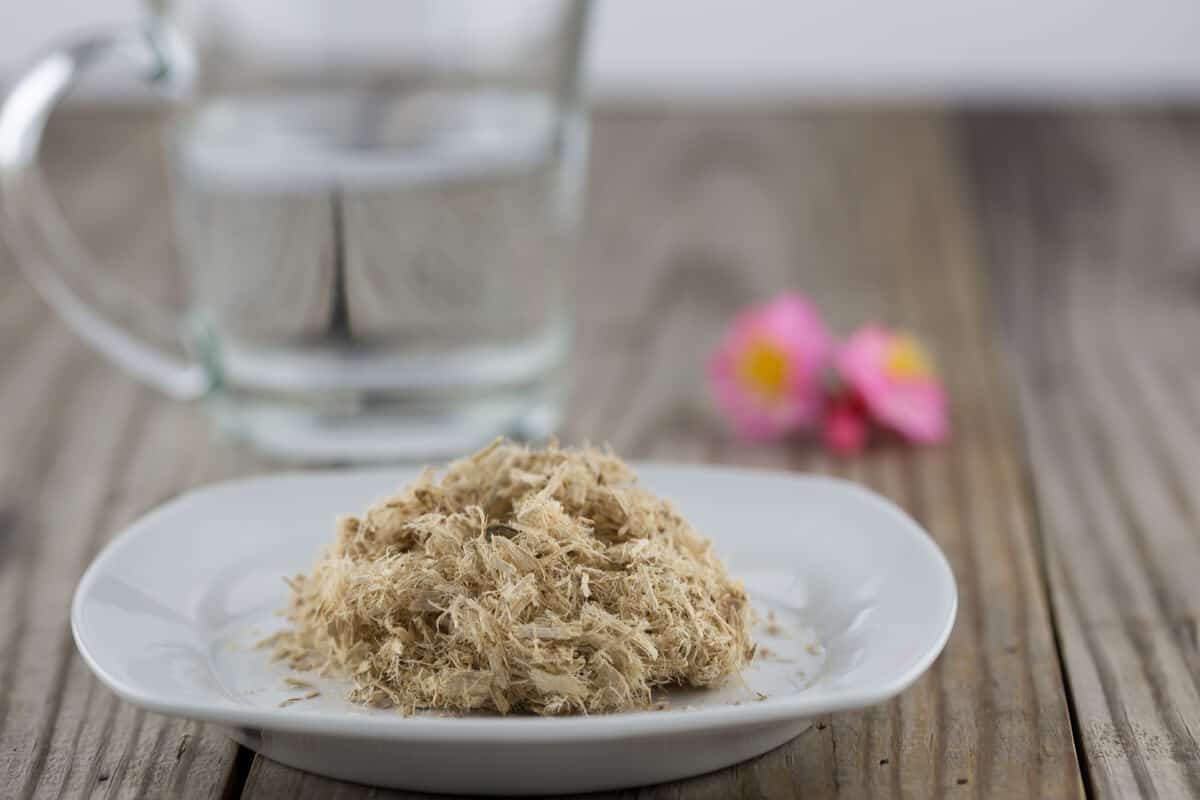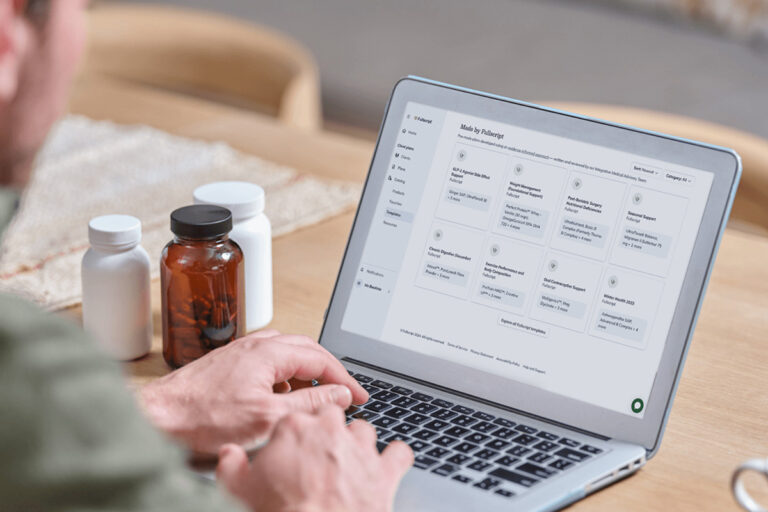What does slippery elm contain?
The key components of slippery elm that give it its many benefits are the mucilage and tannins. (11) Slippery elm is predominantly composed of mucilage- which is the component responsible for creating that gel-like substance when it is mixed with water. (11) About 3% of slippery elm contains tannins, which helps tissues of the body (e.g., skin) to contract and enhance its protective layers of defense, by not allowing pathogens to enter as easily. (11)
Slippery elm forms a gel-like substance when mixed with water.
Slippery elm benefits
Slippery elm benefits many body systems, ranging from gastrointestinal to skin issues.Soothes irritated tissue
The thick gel that slippery elm forms when mixed with water allows it to act as a demulcent (11), a substance that forms a protective coating over mucous membranes, such as those in the mouth and throat, thereby helping to soothe irritated tissues. (11) As a result, slippery elm has been used to improve a wide range of conditions involving irritated and inflamed tissue, ranging from a sore throat to ulcerative conditions. (7)(11) A clinical trial found that a natural formulation that consisted of a mixture of dried powdered slippery elm bark, lactulose, oat bran, and licorice root helped to improve symptoms in people with irritable bowel syndrome (IBS) (5), a condition affecting the intestine, characterized by changes in bowel patterns, problems with motility, and abdominal pain. (2) The study found that slippery elm was predominantly beneficial for IBS with predominant constipation. (5) Participants experienced a significant increase in bowel movement frequency, improvements in stool consistency and reductions in straining, abdominal pain, bloating, and IBS symptom severity. (5) Another study found that a gut relief formula containing curcumin, aloe vera, slippery elm, guar gum, pectin, peppermint oil, and glutamine with slippery elm significantly improved outcomes in patients with gastroesophageal reflux disease (GERD), commonly referred to as heartburn. (8) Patients with GERD often experience a burning sensation and irritation of the esophageal lining due to stomach acid/contents that are regurgitated up into the esophagus. (1) Almost half of the participants taking proton pump inhibitors, a type of medication for GERD, no longer required pharmaceutical treatment at the end of the study. (8) A third of participants were able to reintroduce food triggers, such as garlic, onion, beans, spicy foods, caffeine, tomatoes, and citrus foods, into their diet after three months without symptom aggravation. (8) The same gut relief formula also significantly improved other gastrointestinal symptoms, including indigestion, nausea, constipation, diarrhea, and reduced intestinal permeability. (8) Intestinal permeability refers to the potential for nutrients and microorganisms to pass through a weakened intestinal wall. (6) Dysfunctions in intestinal permeability can result in leaky gut, a condition in which larger molecules (i.e., partially digested food, pathogens or toxins) pass through the intestinal lining into the blood, potentially triggering the immune system, inflammation, and/or illness. (6)
Slippery elm has been shown to improve a variety of upper and lower gastrointestinal issues.
Supports wound healing
Traditionally, slippery elm has also been used as a topical treatment for healing wounds and inflammatory skin conditions. (4) This can be attributed to the tannins in slippery elm, as tannins are used as supportive therapy for treatment of conditions such as acute eczema and shingles. (4) Tannins give slippery elm its astringent property, which ultimately allows for contraction of the skin tissue. This occurs because tannins bind with protein-rich structures of the skin, such as collagen, and precipitate proteins to the surface. The precipitation of proteins and sealing of cell membranes allows for expedited wound closure and healing and prevents pathogen invasion.Provides prebiotic effects
Slippery elm may also have prebiotic potential that could benefit our gastrointestinal and overall health. Prebiotics are food components that we can not break down, but they act as food and promote the growth and activity of beneficial bacteria (microbiota) that reside in our gut. Researchers at the University of California San Diego used human fecal cultivation to investigate whether certain medicinal herbs alter the growth and abundance of specific bacterial species. (7) It was found that slippery elm increased the abundance of many kinds of bacteria known to promote human health, such as Bifidobacterium, Lactobacillus, and Bacteroides. (7) Many of the bacteria that were increased by slippery elm were butyrate-producing bacteria. (7) Butyrate acts as fuel for the cells lining our gut, allowing them to function optimally. Additionally, slippery elm reduced the abundance of potential pathogens, such as Citrobacter freundii and Klebsiella pneumoniae. (7)Safety considerations
Slippery elm is generally safe to use, but may act as an irritant or allergen to the skin. Contact dermatitis, which may involve redness, inflammation of the skin, and hives, has been reported after topical exposure to slippery elm. (3)The bottom line
Slippery elm can be used internally and externally to help heal many conditions due to its demulcent and astringent actions. It has been shown to be effective when used topically to treat wounds and skin condition and when used internally to treat inflammation of digestive, respiratory, and urinary systems. (9)- American Academy of Allergy Asthma & Immunology. (n.d.). Gastroesophageal Reflux Disease Symptoms, Diagnosis & Treatment. https://www.aaaai.org/Conditions-Treatments/related-conditions/gastroesophageal-reflux-disease
- Canadian Digestive Health Foundation. (2021, January 27). What is Irritable bowel syndrome (IBS)? https://cdhf.ca/digestive-disorders/irritable-bowel-syndrome-ibs/what-is-irritable-bowel-syndrome-ibs/
- Czarnecki, D., Nixon, R., Bekhor, P., & Mason, G. (1993). Delayed prolonged contact urticaria from the elm tree. Contact Dermatitis, 28(3), 196–197.
- Fölster-Holst, R., & Latussek, E. (2007). Synthetic Tannins in Dermatology?A Therapeutic Option in a Variety of Pediatric Dermatoses. Pediatric Dermatology, 24(3), 296–301.
- Hawrelak, J. A., & Myers, S. P. (2010). Effects of Two Natural Medicine Formulations on Irritable Bowel Syndrome Symptoms: A Pilot Study. The Journal of Alternative and Complementary Medicine, 16(10), 1065–1071.
- Meletis, C. D., & Zabriskie, N. (2008). Supporting Gastrointestinal Health with Nutritional Therapy. Alternative and Complementary Therapies, 14(3), 132–138.
- Peterson, C. T., Sharma, V., Uchitel, S., Denniston, K., Chopra, D., Mills, P. J., & Peterson, S. N. (2018). Prebiotic Potential of Herbal Medicines Used in Digestive Health and Disease. The Journal of Alternative and Complementary Medicine, 24(7), 656–665.
- Ried, K., Travica, N., Dorairaj, R., & Sali, A. (2020). Herbal formula improves upper and lower gastrointestinal symptoms and gut health in Australian adults with digestive disorders. Nutrition Research, 76, 37–51.
- Smith, T. (n.d.). American Herbal Pharmacopoeia Releases New Monographs on American Ginseng Root and Slippery Elm Inner Bark – American Botanical Council. American Botanical Council. http://herbalgram.org/resources/herbalgram/issues/94/table-of-contents/orgnews_ahpmonos/
- Tree Canada. (n.d.). Slippery elm (Ulmus rubra) – Tree Canada. https://treecanada.ca/resources/trees-of-canada/slippery-elm-ulmus-rubra/
- Watts, C., & rousseau, B. (2012). Slippery Elm, its Biochemistry, and use as a Complementary and Alternative Treatment for Laryngeal Irritation. Journal of Investigational Biochemistry, 1(1), 17.





